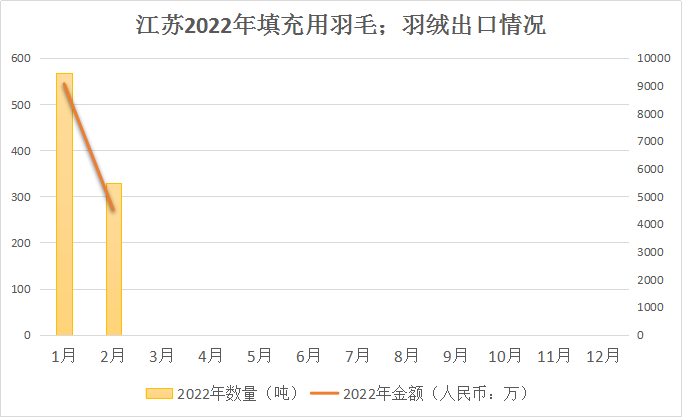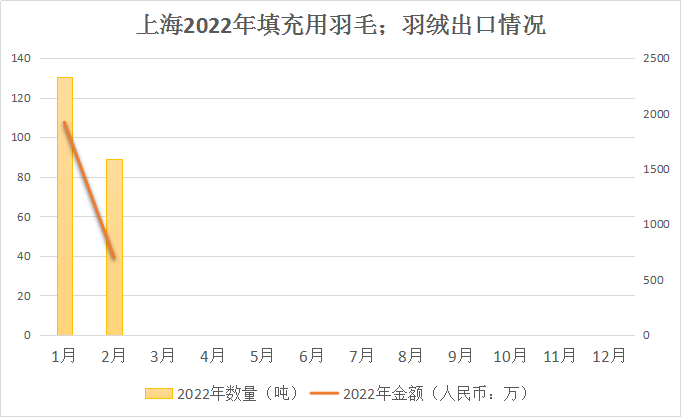Cn-down > Domestic news > News content
2022-03-28 来源:羽绒金网 浏览量:2413
summary
At present, the domestic epidemic situation is spreading in many places, and at the same time, various regions have also stepped up prevention and control measures and adhered to the action of "dynamic clearing". All of these have a certain impact on the production, transportation and sales of enterprises.
The feather and down trade has also been impacted by the general environment. Uncertain factors have disrupted the normal supply and demand relationship, making both upstream and downstream manufacturers wait and see. It is worth noting that with the improvement of market traffic control and investment sentiment, the price of ducklings has rebounded for several consecutive days.
China's textile and apparel market is based on "three points for domestic demand and seven points for exports", and since the Sino-US trade war started, the speed of end customers placing orders has slowed down significantly. The good news is that the United States has restored 352 tariff exemptions for Chinese imports, which undoubtedly gave the textile market a shot in the arm.
Exchange rate of USD to RMB: 6.3677

Exchange rate of USD to RMB: 6.3664

Exchange rate of USD to RMB: 6.3558

Exchange rate of USD to RMB: 6.364

Exchange rate of USD to RMB: 6.3739

good news
On the 23rd local time, the Office of the United States Trade Representative issued a statement announcing the re-exemption of 352 additional tariffs on imports from China, which will apply to imports between October 12, 2021 and December 31, 2022. Goods from China.
In October last year, U.S. Trade Representative Dai Qi announced plans to re-exempt tariffs on 549 items imported from China, and sought public comments on this. However, this time only 352 of the 549 Chinese imports were confirmed.

This waiver is retroactive to October 12, 2021 at 12:01 a.m. EDT, and further extensions may be considered at discretion.
These include 0505.10.0050 Feather, 0505.10.0055 Down and 9404.90.1000 Cotton Pillow Filled with Duck or Goose Down (see table below for details):
| 税号及产品描述 |
美国税号: Feathers(Meeting both test standards 4 and 10.1 of Federal Standard 148a promulgated by the General Services Administration) 羽毛(符合总务管理局颁布的联邦标准148a第4和10.1条的试验标准) |
美国税号: Down(Meeting both test standards 4 and 10.1 of Federal Standard 148a promulgated by the General Services Administration) 羽绒(符合总务管理局颁布的联邦标准148a第4和10.1条的试验标准) |
| 美国税号: Pillow shells of cotton, each filled with goose or duck down 填充鸭绒或鹅绒的棉质枕头 |
Among the 549 imported commodities that are not included in the 352 exemption list, there are still 0505.10.0060 goose and duck feathers for stuffing (see the table below for details):
| 税号及产品描述 |
| 美国税号: Feathers of a kind used for stuffing, of ducks or geese, not further worked than cleaned, disinfected or treated for preservation, the foregoing other than feathers meeting both test standards 4 and 10.1 of Federal Standard 148a promulgated by the General Services Administration 填充用鹅鸭羽毛,经清洗、消毒或保存处理,未经进一步加工(符合总务管理局颁布的联邦标准148a第4和10.1条测试标准的羽毛除外) |
The goods in the above two tables were excluded from additional tariffs from September 1, 2019 to December 31, 2020, and the 7.5% tariff will be resumed from January 1, 2021.
During the Trump administration, the U.S. government initially approved tariff exemptions on more than 2,200 Chinese goods to ease the burden on certain industries and retailers. Of these, exemptions for most goods expired, but tariff exemptions for 549 items were extended for a year, expiring at the end of 2020.
The spokesperson of the Ministry of Commerce said: In the current situation of rising inflation and challenges to the global economic recovery, we hope that the United States will proceed from the fundamental interests of consumers and producers in China and the United States, cancel all additional tariffs on China as soon as possible, and promote bilateral economic and trade cooperation. The relationship is back on track sooner rather than later.
The link to this USTR announcement and the list of tariff-exempt goods is: https://ustr.gov/sites/default/files/notices/FRN%20for%20Notice%20of%20Reinstatement.pdf
Although the "cold spring" of the new crown pneumonia epidemic is still severe, as a world-renowned brand of down jackets, the Bosideng Group located in Changshu City has ushered in the "spring" of export sales.
In the production workshop at the headquarters of Bosideng Group, sewing machines are running at high speed, and workers are busy in an orderly manner. In the first two months of this year, Bosideng has exported 30.763 million yuan of textiles and clothing, an increase of 11.5% year-on-year.

"Now our garments are mainly exported to North America, EU countries and the United Kingdom. Since March, our export volume has gradually increased. It is expected that a large number of exports will begin in April, and the peak export season will continue until September. "Bosideng Foreign Trade Division Shipping Management Manager Xu Fuming introduced.
Xu Fuming also happily calculated: "We have made reasonable use of the free trade agreement to obtain more benefits. In the first two months of this year alone, we have enjoyed tariff concessions of about US$22,000 by applying for the FTA preferential certificate of origin. Let's wait. Orders exported to Japan are being shipped one after another, and according to the RCEP tariff reduction policy, we will also enjoy at least US$37,000 in tariff concessions.”
The export volume from January to February, Anhui ranked first in the country, and was the highest in the same period in the province since 2017.
According to China Customs data, Anhui Province exported 3,046.2 tons of down and feathers from January to February, a year-on-year increase of 33.9%; the export value was 252 million yuan, a year-on-year increase of 107.9%.
Anhui Province exported 1620.4 tons of down and feathers in January, with an export value of 155 million yuan; in February, it exported 1425.8 tons of down and feathers, with an export value of 97 million yuan.

From January to February, Zhejiang ranked first in the country.
From January to February, Zhejiang Province exported 2,770.5 tons of down and feathers, a year-on-year increase of 29.6%; the export value was 335 million yuan, a year-on-year increase of 41.8%.
Zhejiang Province exported 1896.6 tons of down and feathers in January, with an export value of 242 million yuan; in February, it exported 873.9 tons of down and feathers, with an export value of 93 million yuan.

Exports from Jiangsu continued to decline.
Jiangsu Province exported 896.5 tons of down and feathers from January to February, down 16.3% from last year; the export value was 136 million yuan, up 78.6% from last year.
Jiangsu Province exported 567.5 tons of down and feathers in January, with an export value of 91 million yuan; in February, 329.0 tons of down and feathers were exported, with an export value of 45 million yuan.

Guangdong Province exported 454.8 tons of down and feathers from January to February, an increase of 72.2% year-on-year; the export value was 36 million yuan, an increase of 18.3% year-on-year.

From January to February, Shanghai exported 219.5 tons of down and feathers, an increase of 3351.4% year-on-year; the export value was 26 million yuan, an increase of 1268.1% year-on-year.

Hunan Province exported 171.5 tons of down and feathers from January to February, a year-on-year decrease of 68.7%; the export value was 83 million yuan, a year-on-year decrease of 66.5%.

bad news
At present, industries such as hotels and tourism have been significantly affected by the epidemic.

In the past, more than 70% of the orders of Foshan Bariya Down Products Co., Ltd. (hereinafter referred to as "Baliya Down") came from hotels. At present, under the influence of the epidemic, hotel orders have declined significantly, and only about 10% of the production capacity can be met.
 热门排行
中国三大羽绒生产基地之—广东吴川
全球最奢侈羽绒服排行
一件羽绒服需要多少只鸭子的羽绒?
飞丝是什么?能代替羽绒?别被骗了,三种方法让你告别假羽绒服!
2017羽绒原料价格一路上涨,究竟为何?
你的羽绒服为什么钻绒?涨知识了
羽绒被的价格一般是多少 通过成本看羽绒被价格
中国羽绒服四大品牌调查:到底谁才是最强王者?
羽绒金网:羽毛、羽绒、毛绒计价
《羽绒羽毛》、《羽绒羽毛检验方法》新版标准发布,2017年7月1日实施
热门排行
中国三大羽绒生产基地之—广东吴川
全球最奢侈羽绒服排行
一件羽绒服需要多少只鸭子的羽绒?
飞丝是什么?能代替羽绒?别被骗了,三种方法让你告别假羽绒服!
2017羽绒原料价格一路上涨,究竟为何?
你的羽绒服为什么钻绒?涨知识了
羽绒被的价格一般是多少 通过成本看羽绒被价格
中国羽绒服四大品牌调查:到底谁才是最强王者?
羽绒金网:羽毛、羽绒、毛绒计价
《羽绒羽毛》、《羽绒羽毛检验方法》新版标准发布,2017年7月1日实施
 推荐阅读
“吴川力量”助中国羽绒接轨世界
中国三大羽绒生产基地之—广东吴川
中羽协第二期新国标培训班 在“羽绒之乡”广东吴川成功举办
羽绒之乡:贵港桥圩镇将打造旅游休闲特色小镇
广西贵港桥圩镇:打造中国羽绒休闲旅游特色小镇
羽绒金网:羽毛、羽绒、毛绒计价
羽绒别急着收 中央气象台发布寒潮蓝色预警 部分地区降温超12℃
上海消保委检测 千元鹅绒被用鸭毛绒填充
冻哭丨降温10℃!鸡年首个寒潮预警来袭,你准备好了吗?
传统羽绒产业如何实现转型升级?四川玉泉镇产业集群发展
推荐阅读
“吴川力量”助中国羽绒接轨世界
中国三大羽绒生产基地之—广东吴川
中羽协第二期新国标培训班 在“羽绒之乡”广东吴川成功举办
羽绒之乡:贵港桥圩镇将打造旅游休闲特色小镇
广西贵港桥圩镇:打造中国羽绒休闲旅游特色小镇
羽绒金网:羽毛、羽绒、毛绒计价
羽绒别急着收 中央气象台发布寒潮蓝色预警 部分地区降温超12℃
上海消保委检测 千元鹅绒被用鸭毛绒填充
冻哭丨降温10℃!鸡年首个寒潮预警来袭,你准备好了吗?
传统羽绒产业如何实现转型升级?四川玉泉镇产业集群发展